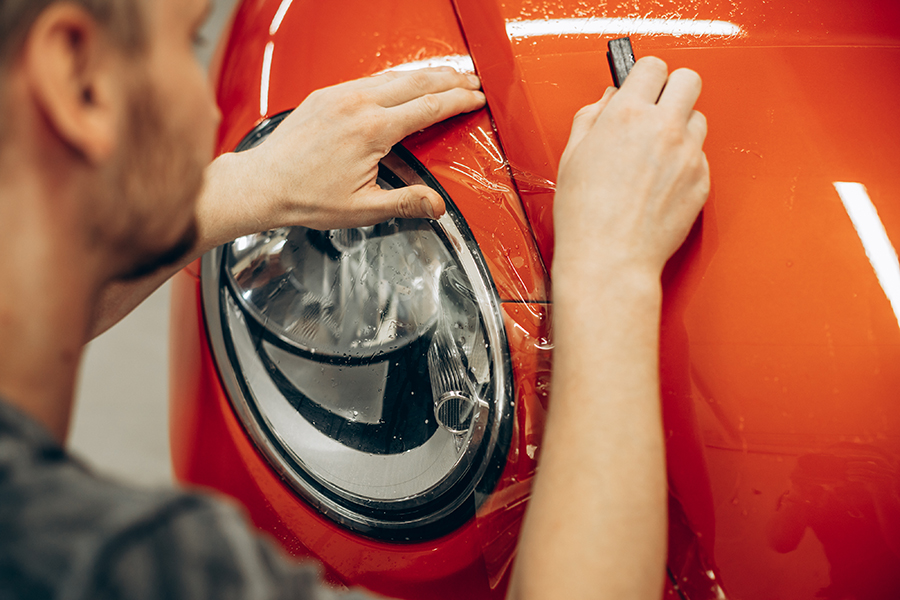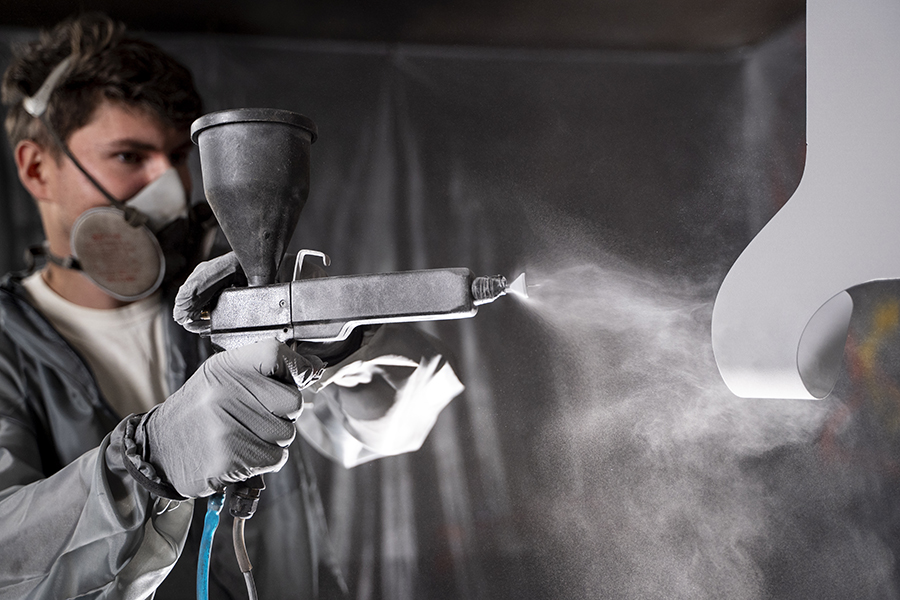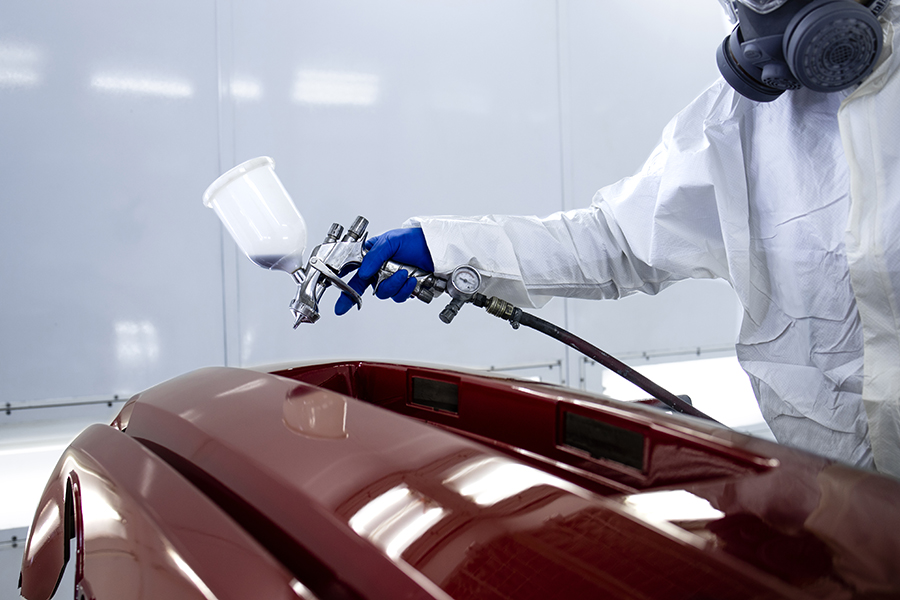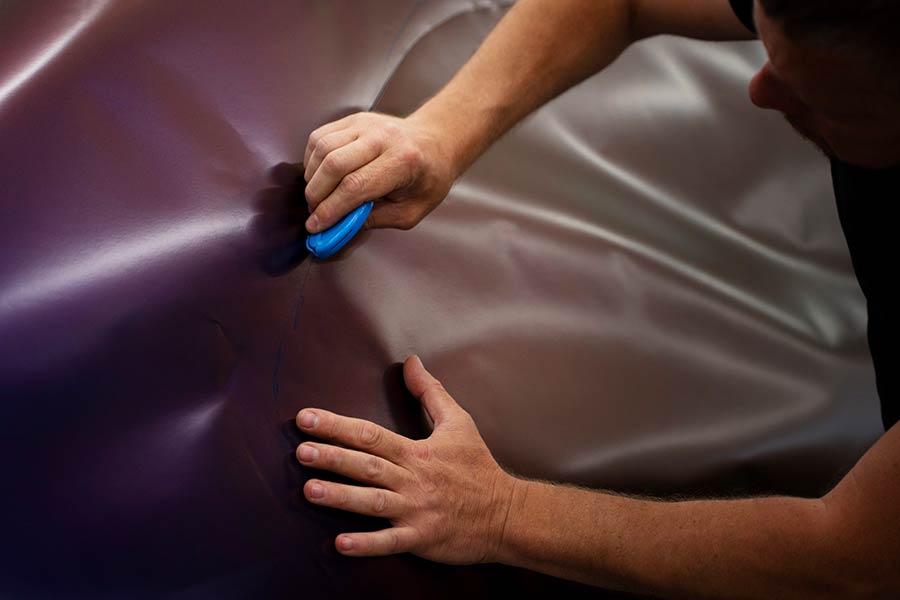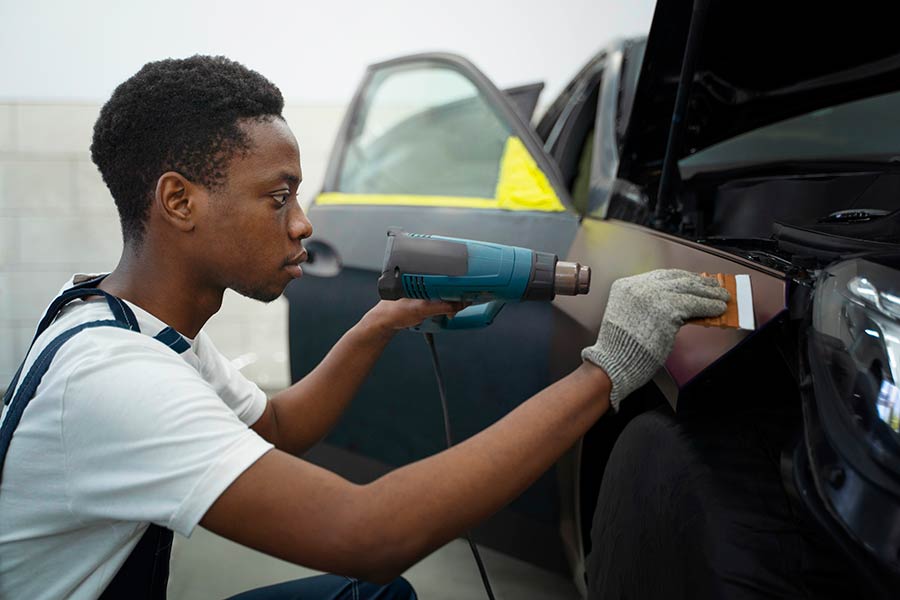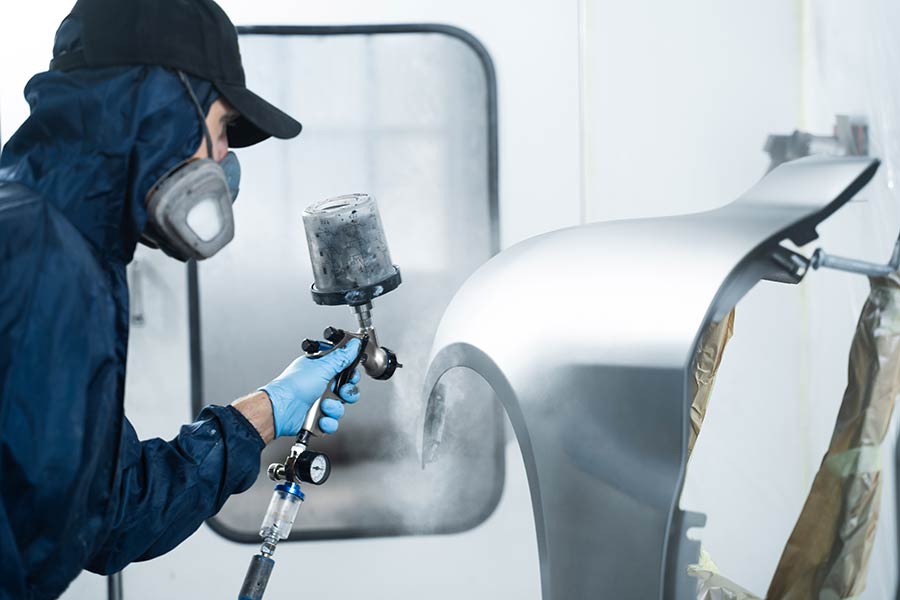Did you know that the average car owner spends $150 to $2,500 on scratch repairs each year?
That heart-sinking moment when you spot a scratch on your car’s pristine paint job is something every car owner dreads. Whether it’s from a shopping cart, a careless driver, or an unfortunate brush with a bush, scratches can seriously impact your car’s appearance and value.
We’ve spent years perfecting scratch repair on car paint, and we know exactly what works and what doesn’t. From simple surface marks to deep paint damage, each type of scratch needs a specific approach for the best results.
In this guide, we’ll walk you through our proven methods for fixing different types of scratches, share professional techniques, and show you when to tackle repairs yourself versus calling in the experts. Let’s fix that paint job and get your car looking showroom-ready again!
Types of Car Paint Scratches
In my years of experience with car paint repairs, I’ve found that understanding the type of scratch you’re dealing with is crucial for successful repair. Let me break down the three main types of scratches we see most often.
Surface Level Clear Coat Scratches
The most common scratches we deal with affect only the clear coat - the transparent protective layer on top of your car’s paint. When I run my fingernail across these scratches, they’re barely noticeable to the touch. These marks typically show up as fine lines or swirl marks that become visible mainly under direct light.
Here’s what makes clear coat scratches stand out: * They appear as light scratches visible mainly in sunlight * Your fingernail won’t catch when running across them * They look like subtle swirl marks or fine lines * The base paint color isn’t visible through the scratch
Paint Layer Damage Assessment
Moving deeper, paint layer scratches are more serious. I can tell a scratch has reached the paint layer when my fingernail catches slightly on the edge. These scratches show the base color of your car and might have a slightly rough texture. The paint layer acts as your car’s color coat, and any damage here needs swift attention.
Deep Primer and Metal Scratches
The most severe scratches I encounter go past the paint and into the primer or metal. These are immediately obvious - you’ll see white or gray primer, or even silvery metal showing through. When my fingernail catches deeply in the scratch, that’s a clear sign we’re dealing with primer or metal damage. These scratches need immediate attention because they can lead to rust and serious structural issues.
What makes these deep scratches particularly concerning is their potential for long-term damage. I’ve seen countless cases where delayed repair led to rust formation and much more expensive fixes down the line. The exposed metal acts like an open door for moisture and corrosive elements to attack your car’s body.
Professional Repair Methods
When it comes to professional scratch repair on car paint, I’ve seen firsthand how modern technology and precise techniques make a world of difference. Let me share the professional methods we use in our shop that set us apart from basic DIY fixes.
Paint Matching Technology
In our professional shop, we rely on a sophisticated device called a spectrophotometer. This advanced tool measures the exact amount of light and specific hues in your car’s current paint finish. By combining this data with your vehicle’s VIN, we create a perfect color match that looks factory-fresh.
The benefits of professional paint matching include: * Perfect color alignment with existing paint * Seamless blending with surrounding panels * No visible repair lines or color variations * Long-lasting results that maintain value
Spray Painting Techniques
I always maintain strict control over our spray environment. The ideal conditions we maintain are 70°F temperature and below 50% humidity. This precision matters - I’ve seen countless DIY jobs fail simply because of poor environmental control.
In our spray booth, we follow a systematic approach: 1. Apply anchor coat for adhesion 2. Layer color coats with proper flash times 3. Build depth gradually for perfect coverage 4. Monitor temperature and humidity constantly
Clear Coat Application
The final stage involves applying our professional-grade 2K clear coat. This two-component system creates an incredibly durable finish that protects your paint job. I’m particularly careful with clear coat application because it acts like a solvent - too much pressure can remove the basecoat.
We build up multiple thin layers, allowing proper flash time between coats. The result is a deep, glossy finish that looks better than new. After curing, we use professional-grade rubbing compound for that mirror-like shine that makes your car stand out.
DIY Repair Steps
After showing you the professional methods, let me share my tried-and-tested DIY approach for scratch repair on car paint. I’ve helped countless car owners fix their paint scratches at home, and these steps work wonderfully for most surface-level damage.
Required Tools and Materials
Before starting any repair work, I always gather these essential items:
- 1000-2000 grit sandpaper
- Car polish and rubbing compound
- Microfiber cloths
- Touch-up paint matching your car’s color
- Car wash soap
- Clear coat
- Paint thinner (for touch-up paint)
- Safety gear (gloves, mask, eye protection)
Surface Preparation Process
I start by washing the scratched area with car soap and water. This step is crucial - any dirt or debris will ruin your repair job. After drying, I check the scratch depth again (as we discussed in the scratch types section).
For the best results, I sand the area with 1000-grit sandpaper for deeper scratches, moving to 2000-grit for a smoother finish. The key here is gentle, circular motions - too much pressure will damage the paint further.
Paint Application Methods
The paint application process I follow changes based on the scratch depth:
- For clear coat scratches: I apply rubbing compound in circular motions, then polish
- For paint layer damage: I clean the area, apply touch-up paint with a fine brush
- For primer scratches: I start with touch-up paint, wait for it to dry
- Finally: I add clear coat in thin layers
I’ve found that patience makes perfect - rushing any of these steps leads to visible flaws. Between coats, I wait 20 minutes minimum. For the final clear coat, I apply it gently to avoid disturbing the base coat underneath.
Remember, if you’re not confident about tackling deeper scratches, the professional methods we discussed earlier might be your best choice. But for minor scratches, these DIY steps can save you significant money while giving great results.
Paint Protection Tips
Having shown you how to fix scratches, I want to share my proven strategies for preventing them in the first place. Through my years in the auto industry, I’ve found that protection is far better than repair.
Protective Films and Coatings
I’ve seen remarkable results with Paint Protection Film (PPF) and ceramic coatings. PPF acts like a shield for your car’s paint, with amazing self-healing properties for minor scratches. When I apply PPF to a client’s car, it creates an invisible barrier that takes the damage instead of the paint.
Ceramic coating is my go-to recommendation for overall protection. It forms a chemical bond with your car’s paint, making it resistant to scratches and environmental damage. I particularly value its hydrophobic properties - water beads right off, taking dirt and contaminants with it.
Regular Maintenance Routines
My maintenance approach focuses on these proven methods:
- Two-bucket washing system with pH-balanced soap
- Microfiber wash mitts and drying towels
- Regular waxing every three months
- Clay bar treatment to remove contaminants
- Hand washing in shaded areas
I always tell my clients that proper washing technique matters more than expensive products. Moving your wash mitt in straight lines rather than circles makes a huge difference in preventing swirl marks.
Scratch Prevention Habits
Smart parking habits play a big role in paint protection. I park away from high-traffic areas and avoid spots under trees where sap and bird droppings can damage the paint. When possible, I recommend keeping your car in a garage or using a high-quality car cover.
For daily protection, I suggest maintaining proper distance from other vehicles while driving. Road debris kicks up less paint-damaging material when you keep a safe following distance. I’ve also found that regular cleaning of brake dust and road grime prevents these particles from scratching the paint during future washes.
The combination of physical barriers like PPF, proper maintenance routines, and smart daily habits creates a robust defense against paint damage. While these methods might seem like extra work, they’re much less costly and time-consuming than dealing with scratch repair on car paint later.
Cost Analysis Guide
Let’s talk about the financial side of scratch repair on car paint. Through my experience working with thousands of car owners, I’ve learned that making smart decisions about repair costs can save you significant money while maintaining your car’s value.
DIY vs Professional Services
The cost difference between DIY and professional repairs is substantial. I’ve found that DIY repairs typically cost between $100 and $1,000, while professional services range from $840 to $5,000. Here’s what I tell my clients about both options:
| Repair Type | Average Cost | Quality Level | Best For |
|---|---|---|---|
| DIY | $100-$1,000 | Variable | Minor scratches |
| Professional | $840-$5,000 | High | Deep damage |
Long-term Value Considerations
I always remind my clients that cheap repairs often become expensive problems. When I look at long-term value, I focus on three key factors:
- Paint job quality affects resale value by up to 30% of the car’s worth
- Professional repairs last 5-10 years longer than DIY fixes
- Poor repairs often need redoing, doubling your costs
Insurance Coverage Options
Through my work with insurance companies, I’ve learned the ins and outs of coverage for paint damage. Most policies offer these options:
- Collision coverage: Pays for scratch repair from accidents
- Comprehensive coverage: Handles non-accident damage like vandalism
- Liability coverage: Works when another driver causes the damage
I always tell car owners to check their deductible - if it’s $500 and the repair costs $300, paying out of pocket makes more sense. For deeper scratches needing professional work, filing a claim might be worth it, especially when repair costs go above $1,000.
Remember what I mentioned earlier about paint types and damage assessment? That knowledge becomes crucial when deciding between DIY and professional repairs. If you’re dealing with clear coat scratches, DIY might work well. But for those deep primer scratches we discussed, professional repair often proves more cost-effective in the long run.
Conclusion
Car paint scratches might seem daunting, but proper knowledge and the right approach make repairs manageable. My years of experience have shown that quick action prevents minor scratches from becoming major problems.
Professional paint matching technology and controlled spray environments deliver factory-quality results for deeper scratches. While DIY methods work well for surface damage, serious paint or primer scratches need expert attention. Many car owners who visit my shop wish they had called us sooner - you can Schedule Repair right away to prevent scratch damage from worsening.
Paint protection remains your best defense against future scratches. Regular maintenance, quality protective films, and smart daily habits keep your car looking pristine. Remember the cost analysis - spending a bit more on professional repairs often saves money compared to repeated DIY attempts.
Most importantly, act quickly when you spot any paint damage. Swift action, whether through DIY methods or professional help, protects your car’s value and appearance for years to come.
## FAQs
-
How can I determine the severity of a scratch on my car’s paint? You can assess the scratch severity by running your fingernail across it. If your nail doesn’t catch, it’s likely a surface-level clear coat scratch. If it catches slightly, it’s probably a paint layer scratch. If your nail catches deeply, it may have reached the primer or metal, which requires immediate attention to prevent rust.
-
What are the main types of car paint scratches? There are three main types of car paint scratches: surface-level clear coat scratches (fine lines or swirl marks), paint layer scratches (visible base color), and deep primer or metal scratches (white, gray, or silvery metal showing through).
-
How much does professional car scratch repair typically cost? Professional car scratch repair services usually range from $840 to $5,000, depending on the severity of the damage and the repair method required.
-
Can I repair car paint scratches myself? Yes, you can repair minor scratches yourself using DIY methods. This typically costs between $100 and $1,000. However, for deeper scratches or if you’re not confident in your skills, it’s best to seek professional help.
-
What tools do I need for DIY car scratch repair? Essential tools for DIY car scratch repair include 1000-2000 grit sandpaper, car polish, rubbing compound, microfiber cloths, touch-up paint matching your car’s color, car wash soap, clear coat, paint thinner, and safety gear (gloves, mask, eye protection).
-
How can I protect my car’s paint from scratches? You can protect your car’s paint by applying Paint Protection Film (PPF) or ceramic coating, following regular maintenance routines (like proper washing techniques), and adopting scratch prevention habits such as careful parking and maintaining distance from other vehicles while driving.
-
Does car insurance cover scratch repairs? It depends on your policy. Collision coverage typically pays for scratch repair from accidents, comprehensive coverage handles non-accident damage like vandalism, and liability coverage works when another driver causes the damage. Always check your deductible before filing a claim.
-
How long do professional car paint repairs last? Professional car paint repairs typically last 5-10 years longer than DIY fixes, making them a more cost-effective option in the long run, especially for deeper scratches.
-
What’s the best way to wash my car to prevent scratches? Use a two-bucket washing system with pH-balanced soap, microfiber wash mitts and drying towels. Wash in straight lines rather than circles to prevent swirl marks, and always wash in shaded areas to avoid water spots.
-
How often should I wax my car for paint protection? For optimal paint protection, it’s recommended to wax your car every three months. Regular waxing helps maintain the paint’s shine and provides an additional layer of protection against minor scratches and environmental damage.
